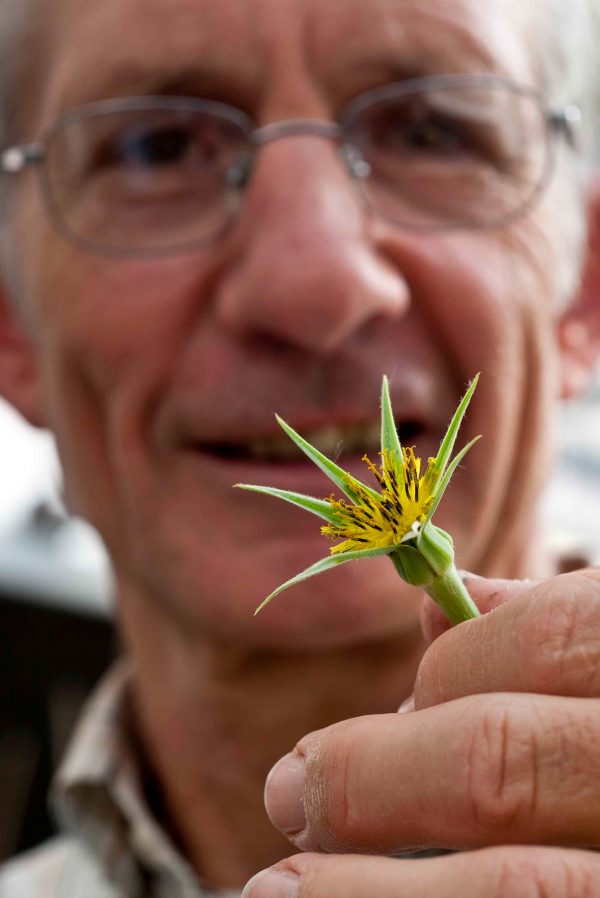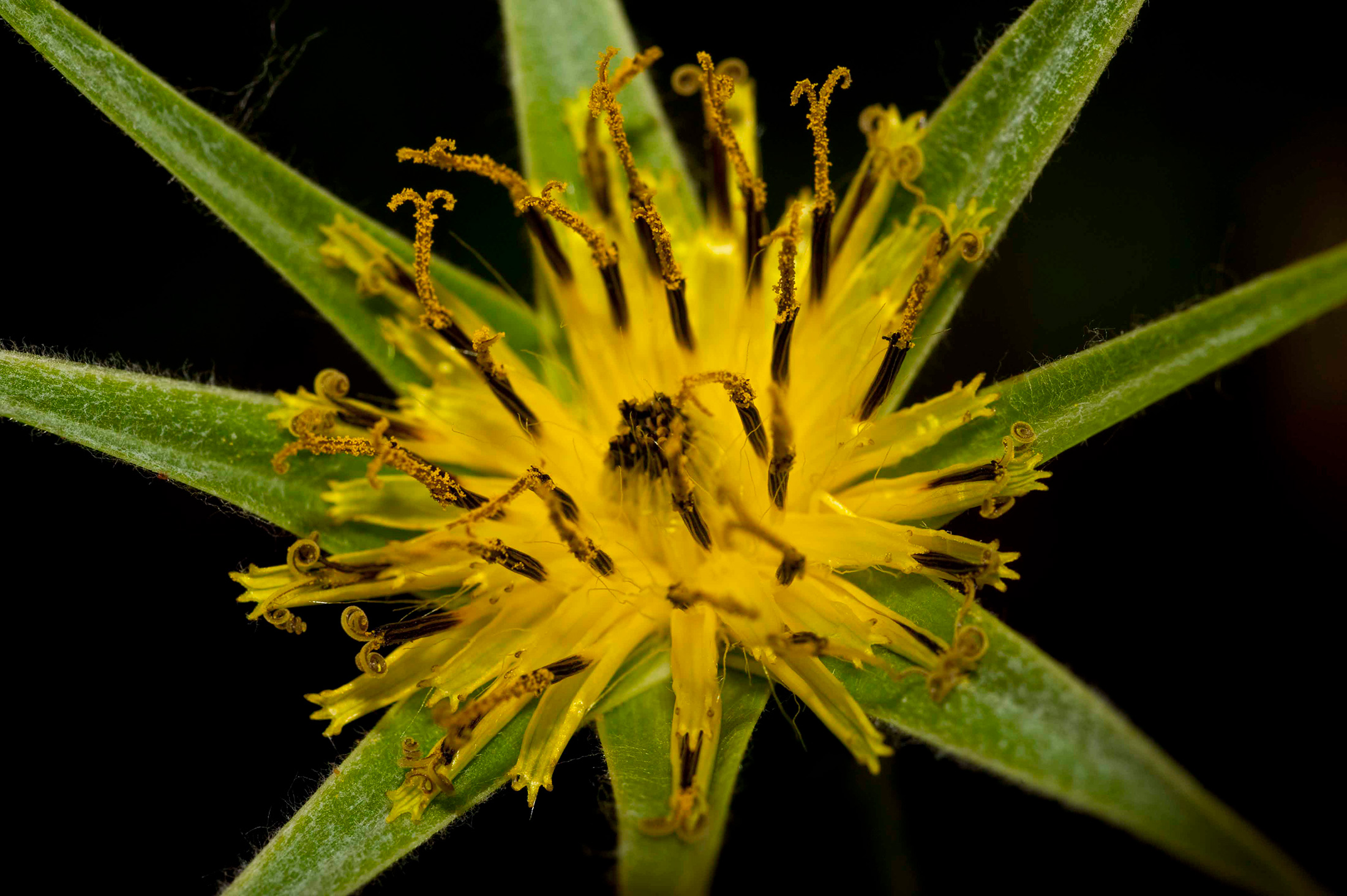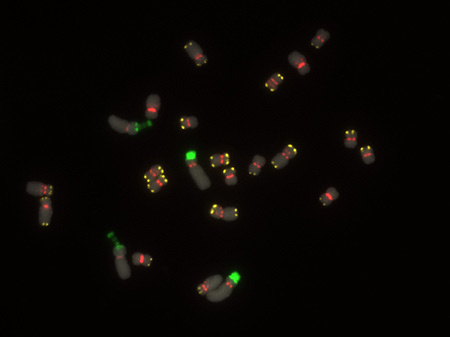For morning drivers on the roadways of the northwestern U.S., an innocuous purple or yellow flower similar to a daisy should be a familiar sight. Widespread and often considered a weed, goatsbeard is also known as “John-go-to-bed-at-noon” because its flower only blooms for a few hours in the morning.

Florida Museum photo by Jeff Gage
The European parent species of this plant never produced fertile hybrid offspring. But once the parents arrived in North America about 80 years ago, they not only formed hybrids, but those hybrids then experienced genome (chromosome) doubling. The parents yielded two new species (Tragopogon mirus and Tragopogon miscellus) native only to North America. Plants of these new species have since multiplied throughout the Pacific Northwest, with estimates of more than 10,000 near Spokane, Wash.
To better understand this phenomenon of genome doubling, which is common in plants, including many crops, Florida Museum of Natural History researchers re-created T. miscellus in UF greenhouses and analyzed its genes and chromosomes to find patterns that may have far-reaching evolutionary consequences.
“We caught evolution in the act,” said Doug Soltis, a distinguished professor in UF’s biology department. “New and diverse patterns of gene expression are seen and these may allow the new species to rapidly adapt in new environments.”
Pam and Doug Soltis have been studying T. miscellus for more than 20 years, and a series of publications have given scientists a clearer view into what happens when a hybrid species experiences a genome duplication event, or polyploidy, following hybridization.
In an initial article published March 17, 2011, in Current Biology, researchers discovered the T. miscellus hybrid showed relaxed gene expression in its earliest generations.
“What we found was a surprise,” said lead author Richard Buggs of Queen Mary University of London, who worked on the study as a postdoctoral researcher at the Florida Museum. “It’s as if hybridization and chromosome doubling hit a reset button on gene expression, turning them all on. This could allow subsequent generations to experiment by switching off different genes.”
The expression of the hybrid plant’s genes in all tissues at all times allowed natural selection to shape what would emerge generations later, said study co-author Pam Soltis, distinguished professor and curator of molecular systematics and evolutionary genetics at the Florida Museum of Natural History. With hybridization followed by chromosome doubling, there is the opportunity for parental patterns to be equalized, as if the new polyploid species has a fresh chance to exhibit a wide variety of genetic expressions over time.
The parent species of T. miscellus, Tragopogon dubius and Tragopogon pratensis, were introduced to the U.S. in the 1920s and the new polyploid species, T. miscellus, was first observed in 1949. Researchers started making the artificial polyploids in 2004 and the plants take about one year to grow from seed to being able to produce seeds, Pam Soltis said.
“No one had extended this to natural populations and the rapidity at which this can occur, and that’s pretty astonishing,” said Jonathan Wendel, professor and chairman of the department of ecology, evolution, and organismal biology at Iowa State University, who was not involved in the study. “That species is such a beautiful model for that.”
Chromosomal variation
Following the processes of hybridization and polyploidy, the new polyploid species Tragopogon miscellus contains 24 chromosomes, which were previously assumed to be represented by 12 from each parent. But a study published in the Proceedings of the National Academy of Sciences Jan. 6, 2012, shows there is more chromosomal variation than expected.

Florida Museum photo by Jeff Gage
“One of the things that makes this so amazing is that where we expected to see 12 chromosomes from each parent (the polyploid has 24 chromosomes), it turns out there aren’t 12 and 12, there are 11 from one parent and 13 from the other, or 10 and 14,” Pam Soltis said. “We’re hoping through some ongoing studies to be able to link these results with the occurrence of another interesting phenomenon – the loss of genes – and also see what effect these changes have on the way the plants grow and perform.”
Because many agricultural crops are older polyploids, the data may be used to develop plants with higher fertility and yields. Polyploid crops include wheat, corn, coffee, apples, broccoli and some rice species.
“It could be occurring in other polyploids, but this sort of methodology just hasn’t been applied to many plant species,” Pam Soltis said. “So it may be that lots of polyploids – including our crops – may not be perfect additive combinations of the two parents, but instead have more chromosomes from one parent or the other.”
Using a technique called “chromosome painting” to observe the plants’ chromosomes, UF postdoctoral researcher and lead author Michael Chester discovered that while whole genome doubling initially results in a new species containing 12 chromosomes from each parent, numbers subsequently vary among many plants.
The paints are made by attaching different dyes to DNA of the two parent species. Once the dye is applied, there is a match between the DNA of the paint and of the chromosome. Under a microscope, the chromosomes appear red or green depending on the parent from which they originated. Sometimes chromosomes are a patchwork of both colors because DNA from the two parents has been swapped as a result of chromosomal rearrangements.

Photo by Michael Chester
“People have looked at these chromosomes before, but until you could apply these beautiful painting techniques, you couldn’t tell which parent they each came from,” Pam Soltis said.
Researchers analyzed about 70 T. miscellus plants raised in UF greenhouses, as well as six natural populations, and found similar results. Of the six populations examined from Washington and Idaho, 69 percent of the plants showed a deviation from the expected 12 and 12 chromosome pattern. To analyze the genomes, researchers collect DNA from the plants’ roots tips.
“In order for most plants to be able to interbreed successfully, their chromosomes need to match up,” Chester said. “That doesn’t necessarily happen when you don’t have equal numbers, so there may be some chromosomal barriers to fertility that develop as a result of this sort of chromosomal variation. This mechanism may also explain low fertility in other plants, such as crops. This is something we are looking into with Tragopogon.”
In the future, researchers hope to connect these patterns of gene loss and chromosomal variation with different features that appear in the hybrid plants, Pam Soltis said.
“Among all of the processes that generate biological diversity in the plant kingdom, genome doubling, or polyploidy, is among the most prevalent and important,” Wendel, of Iowa State University, said in an email. “This is an area that is receiving international focus and research attention, but the system Pam and Doug Soltis are working on is unique.”
Learn more about the Molecular Systematics & Evolutionary Genetics Lab at the Florida Museum.